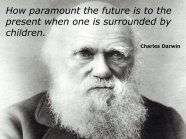On the morning of 27th December, 1831 Charles stood at the rail of this great ship HMS Beagle. Wind blowing in his face and hair. He looked down to where the water lapped on its sides. Robert Fitzroy, the captain of Beagle was busy with the last minutes preparations as the Beagle was ready to set out for its second voyage and this time to South America.
Charles, a naturalist (someone who loves to study nature) was extremely excited to set out on this adventure. The 22 year old did not know then that his findings on this Voyage would completely change the history of mankind. He could not believe that he was on a voyage for his father wanted him to study medicine and become a doctor. He was in charge of collecting plants and animal specimens from all the islands he visited ad studying them later on. Something that he loved to do.
On the 16th of January, 1832, they anchored at Porto Praya, in St. Jago, the chief island of the Cape de Verd archipelago. A white band of a raised beach about forty-five feet above the water, embedded with shells stood out as an interesting part of the island’s natural history. Charles collected the rocks and shells. During the stay there, he also observed the habits of marine animals like octopus, cuttlefish and Aplysia, a sea slug. Most of them changed colors like a chameleon. Charles found that intriguing.
After spending a few days in St. Jago, Beagle moved on towards Brazil. After making quick stops at St Paul and Fernando Noronha, it reached San Salvador, Brazil on Feb. 29th. The lush forests of Brazil enchanted the people on Beagle especially Charles. He studied the different varieties of plants, animals and birds. He noticed that, throughout the long coast of Brazil, there were black shining rocks and white water. Black rocks were actually granitic formation.
Tracing the boundary of South America, Beagle the survey ship charged ahead. Finally, in mid September they reached a group of islands that were far removed from all the rest. It was his stay here that Charles came up with ‘The theory of evolution’. It was Galapagos Archipelago. A group of ten islands. As Charles looked around what caught his attention, was the number of craters around, uninviting bushes and lack of plants. Almost disappointed he walked along and was rewarded by the sighting of two large tortoises weighing almost 200lbs each. He was amazed how the wildlife differed so much from place to place. On further exploration of other islands, he found giant lizards that swam.
The Voyage ended when the Beagle reached England on 2 October 1836. In the next year, he started writing journals about how the surrounding have an effect of the changing of one species into another.
where to find solutions how management fee is calculated how entrepreneur become successful who set up netflix how much science is required for upsc how much manager salary how much device time how much solution in vax platinum when startup repair doesn't work how many design principles are there where does an entrepreneur work who management of malnutrition which project element is an accessibility feature who started whose line is it anyway which development was influenced by the enlightenment when engineering day where to learn technical analysis for free which solution is a homogeneous mixture how technological change affects jobs what equipment is needed for a podcast what are the 3 management process whose system does tello use which solutions does iqbusiness offer which project sekai character are you what management style do you prefer which manufacturer sells the most electric vehicles how often growth spurts how much product photography cost where to travel from london what start up expenses are deductible where technology started how many solution are there to this nonlinear system what london borough am i in when project runway 2022 where to visit from london when equipment is purchased for cash why design thinking is important how community solutions where are lf system from when was startup filmed when system is consistent how much technology should be used in the classroom when teaching systems and routines to a group who entrepreneur for capitalist psychologist and economist how many startups make it









